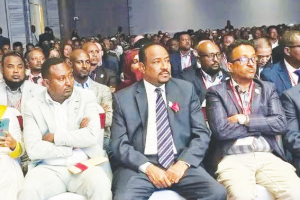
Ethiopia is a country with a rich ancient history, cultural and religious values as well as indigenous knowledge. But little has been done by its scholars and writers to introduce to the world its rich history with different written documents and works of literature, even in few dominant foreign languages in the global arena.
In some part of an Amharic fiction authored by Adam Reta entitled ‘Merek’, I remember reading one of the narrator’s foreigner friend called Milose reflecting his view “Your country has a weak literature culture. I am not talking about the ancient religious books but about the ones being dished out these days. The hand counted books is all about politics. And all your revolutionaries seem imitators. Sometimes I wonder all the books in your country are only three.” As an avid reader myself I relate with this reflection.
Even though the fact is way too far from this, I believe it is the writer’s way of telling that much has not been done in terms of carrying our original history and wisdom to the world via the global medium of communication or global literature.
But it does not come as a surprise if the stories in our books are all about politics and misery. The best and original ones replete with wisdom were looted by different foreigners from different parts of the country. Somehow, despite the fact that there is still much to be done in promoting Ethiopia and its people through global works of literature, some people are taking the initiative by coming up with what they did best.
Conflicts and Terrors is a newly published fiction written by the economist Getachew Minas. As the writer himself put it, the historic setting is based on a story of movements that led to the change of a government. It deals with conflicts and terrors in Ethiopia. It starts with the birth of a boy to poor parents during the Emperor’s regime. He went by the name called Abate .The story describes that time as a period when the life style of two different classes, the feudal and peasants, resulted in a turning point that would lead to a certain revolution by the children of the peasants who had the chance to go to school.
The situation threatened to become a clear danger to the government. So, some of the ruling class advised the emperor to reduce the number of children that went to school. There was no school free at that the time, while others suggested a land reform that would slow down the impending revolution. However, there was no consensus among the leadership to change the situation, as the writer narrates.
That was the time children like Abate joined the world, went to school, grew up and went through several ups and downs being part of a story where revolution was born from the students’ movement. They toppled the emperor regime and led the country to consecutive years of conflicts and terrors under the iron grip of a communist military regime.
The role of the students’ movement and the cadres from kebele to higher levels of the communist regime in the revolution takes the bigger segment in the story. Abate is one of the major characters that represented the educated revolutionaries from the poor society and who got involved in the students movement. He passed through the overwhelming bureaucratic civil servant posts and dedicated his life for a revolution that had been hijacked by the military troops and opportunists.
Meanwhile, the way he managed to pursue his education parallel with the responsibility of taking care of his poor mother in financial matters , how he managed to obtain an overseas higher education scholarship opportunity that was hidden from him by his envious boss and coming back to the country with his masters degree of economics with his commitment to the revolution, the one he gave his life for, showcases how the writer is committed to present a story with strong words and to some extent an impressive third person narrative style.
The facts that the students, even those who studied abroad, used to argue about ideologies and social status as well as the future faith of their country are well narrated with interesting antagonistic and intellectual dialogues among the characters.
The narration being about Ethiopian students in a foreign country and the reason for their isolation while living among other students from Africa are also the touchy part of the story that would afford a new understanding about how that generation framed its identity.
The students’ movement caused the overthrow of the emperor regime to pave way to a communist leadership, which was hijacked by the military. A very complicated situation unfolded. One turned another’s enemy. That led to the abortion of the revolution that was meant for the wellbeing of the broad mass.
This was well portrayed in the story as the ambition for power, hatred, public passion, envy, greed, commitment and honesty were largely discussed from several perspectives by the narrator. The fictional characters are portrayed based on the situations and exact realities of the society that lived at that particular time. That means the writer has tried to show readers the exact image of the society.
However, since the story tries to touch upon many pieces of realities during that period of time, to some extent, its fractured plots do not present a very strong scenario that pulls tight all the stories together. It seems that the writer has faced difficulties in setting his plot on the lives of some major characters but rather he has developed the story by creating so many new nameless characters that come and disappear from the story all of a sudden. This could be the effect of the wide expanded history of the time that the writer tried to cover.
The other factor, which this reviewer assumes as a small but unnecessary inconvenience in the book is that it has so many insignificant sub titles, which made the book look like an academic module instead of keeping its fictional nature. This also affected the sequential flow of the story as the titles change rapidly with new characters and scenarios even if they have contributions for the story not to lose its core idea or theme.
One additional basic inconvenience in the story is that there are some parts of dialogues that would begin with a speech of one character and end up without closing the quote or letting the reader to understand who exactly said the words. This could be an oversight that may lessen the quality of the literature value in the book or story.
To conclude, the historical facts that are presented in the story have their own significant values for readers who would like to have a new perspective of what went on in the country and the moral, intellectual and psychological makeup of the young generation during that time.
The multifaceted ideologies and philosophies entwined with the people’s life styles have been described in the narration with strong figurative speeches, proverbs and dialogues between the characters in the story. That adds to the literary prowess of the author.
Had the writer took more time in keeping track of his short existing characters, most of the issues raised in the book would have had their own detailed stories and given the novel more depth.
For instance, the character named as the ‘Chat Guy’ was one of the characters that should have been kept for more ideological arguments for he has his own basic concept on the realities between bourgeois, proletariats and the issues of different nationalities.
Somehow, the emergence of authors who publish such fictional works is crucial to introduce the literature, history, culture and overall lifestyle of the people. And I would also like to say it is an interesting work of literature.
The Ethiopian Herald Sunday Edition 10 November 2019
BY HENOK TIBEBU





